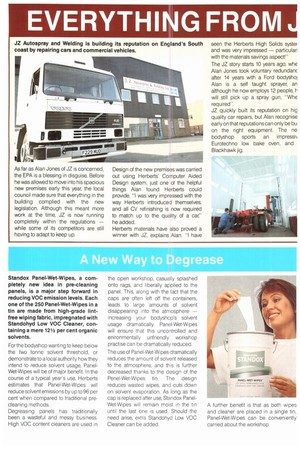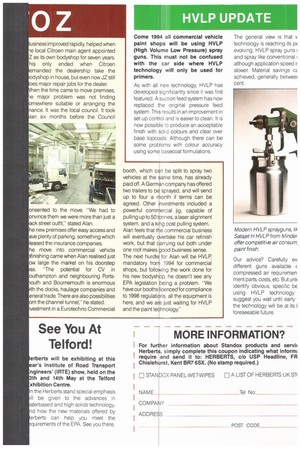For the bodyshop wanting to keep below the two tonne
Page 110

Page 111

If you've noticed an error in this article please click here to report it so we can fix it.
solvent threshold, or demonstrate to a local authority how they intend to reduce solvent usage, PanelWet-Wi pes will be of major benefit. In the course of a typical year's use, Herberts estimates that Panel-Wet-Wipes will reduce solvent emissions by up to 96 per cent when compared to traditional precleaning methods.
Degreasing panels has traditionally been a wasteful and messy business. High VOC content cleaners are used in the open workshop, casually splashed onto rags, and liberally applied to the panel. This, along with the fact that the caps are often left off the containers, leads to large amounts of solvent disappearing into the atmosphere — increasing your bodyshop's solvent usage dramatically. Panel-Wet-Wipes will ensure that this uncontrolled and enironmentally unfriendly workshop practise can be dramatically reduced.
The use of Panel-Wet-Wipes dramatically reduces the amount of solvent released to the atmosphere, and this is further decreased thanks to the design of the Penel-Wet-Wipes tin. The design reduces wasted wipes, and cuts down on solvent evaporation. As long as the cap is replaced after use, Standox PanelWet-Wipes will remain moist in the tin until the last one is used. Should the need arise, extra Standohyd Low VOC Cleaner can be added. usiness improved rapidly, helped when e local Citroen main agent appointed Z as its own bodyshop for seven years. his only ended when Citroen emanded the dealership take the odyshop in house, but even now JZ still oes major repair jobs for the dealer hen the time came to move premises, e major problem was not finding • mewhere suitable or arranging the nance. It was the local council. It took Ian six months before the Council nsented to the move. We had to nvince them we were more than just a ack street outfit," stated Alan.
he new premises offer easy access and ave plenty of parking, something which leased the insurance companies.
he move into commercial vehicle finishing came when Alan realised just ow large the market on his doorstep as. "The potential for CV in outhampton and neighbouring Portsouth and Bournemouth is enormous ith the docks, haulage companies and eneral trade. There are also possibilities om the channel tunnel: he stated.
vestment in a Eurotechno Commercial Come 1994 all commercial vehicle paint shops will be using HVLP (High Volume Low Pressure) spray guns. This must not be confused with the car side where HVLP technology will only be used for primers.
As with all new technology, HVLP has developed significantly since it was first featured. A suction feed system has now replaced the original pressure feed system. This results in an improvement in set up control and is easier to clean. It is now possible to produce an acceptable finish with solid colours and clear over base topcoats. Although there can be some problems with colour accuracy using some basecoat formulations.
booth, which can be split to spray two vehicles at the same time, has already paid off. A German company has offered two trailers to be sprayed, and will send up to four a month if terms can be agreed. Other investments included a powerful commercial 'jig, capable of pulling up to 50 tonnes, a laser alignment system, and a king post pulling system. Alan feels that the commercial business will eventually overtake his car refinish work, but that carrying out both under one roof makes good business sense. The next hurdle for Alan will be HVLP, mandatory from 1994 for commercial shops, but following the work done for his new bodyshop, he doesn't see any EPA legislation being a problem. "We have our booths lice need for compliance to 1998 regulations. all the equipment is here, and we are just waiting for HVLP and the paint technology." The general view is that v technology is reaching its PE evolving. HVLP spray guns' and spray like conventional although application speed slower. Material savings CE achieved, generally betweei cent.
Modern HVLP spraygbns, Ii Sataiet H HVLP from Minder offer competitive air consum paint finish.
Our advice? Carefully ev different guns available compressed air requiremeni ment parts, costs, etc. But unl( identify obvious, specific be using HVLP technology suggest you wait until early the technology will be at its 1 foreseeable future.
































































































































